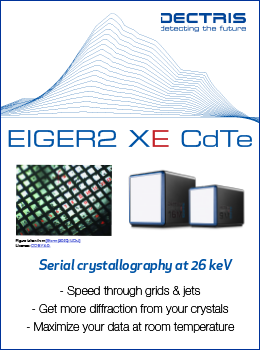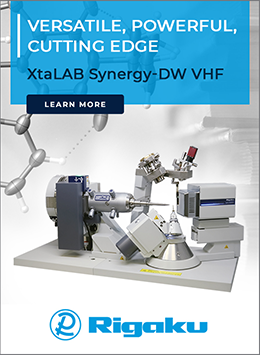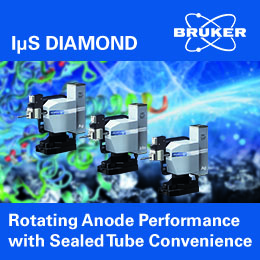
History of crystallography
Squaring the blue four-circle
![lysozyme [lysozyme]](https://www.iucr.org/__data/assets/image/0019/148501/lysozyme.gif)
From the 1960s to the 1980s, X-ray data collection in many laboratories in the UK relied on the Hilger & Watts diffractometer, which some may well remember using, fondly, or perhaps not. Collecting macromolecular data often took several months, during which power dips and other electrical instabilities, cooling-system floods, crystal slippage, radiation decay and capillary breakage, as well as helium-gas and paper-tape shortages, all took their toll on your sanity. In the days before automatic indexing, usually the hardest part was determining the orientation matrix. This involved pre-aligning the crystal using a precession camera, transferring it to the diffractometer and then locating a number of strong reflections, usually axial, orthogonal and of known index. Arguably, it was good training for coronavirus stress. As these machines have long since gone to the great resting place for diffractometers, it seemed interesting to catalogue their history, and last year I committed some details to a Wikipedia page and a blog (referenced therein), which have many more details and historical documents than would fit here.
Hilger & Watts was based in several locations in the London, UK, area but diffractometer production centred on the Camden Town factory, which was the largest employer in the area. The company had a long history, dating back to the middle of the 19th century, specialising in the production of scientific instruments (mostly optical), many of which were commissioned in large numbers for military purposes during both world wars. They also supplied space-flight instruments to NASA.
The first diffractometer in the UK (or the world even!) was actually the ionisation spectrometer of W. H. Bragg in 1912–1913, but in the intervening years, X-ray data were mainly collected by film techniques before the advent of computers and more modern instrumentation. The first X-ray diffraction instrument to be produced by Hilger & Watts was known as the linear diffractometer. This had been developed by Uli Arndt and David Phillips [1] at the Royal Institution (RI) in London (see here for a full description). In those pre-internet days, the setting angles for each reflection had to be calculated using the EDSAC computer in Cambridge. To overcome this inconvenience, the team set about developing an analogue method for determining these angles involving protractors and a scale drawing of the crystal lattice. Quoting from Uli Arndt’s autobiography (Arndt, 2006) [2], “David remarked to me one Friday what a pity it was that the rotations of the protractors could not be linked directly to those of the crystal shafts”. Arndt then describes how the following weekend, he borrowed a Meccano set from the son of a sailing friend to try out possible linkages for just such an automatic diffractometer. Having established the feasibility from such humble beginnings, the subsequent design and prototyping took another two years. This was complicated by the fact that Arndt had to spend a year on sabbatical in Wisconsin, communicating with the RI team by transatlantic mail. Following his return to London, a prototype of the machine was exhibited at the Physical Society. This was eventually manufactured under licence by Hilger & Watts, who went on to sell around 100 of these instruments worldwide, as the Y190 model (Fig. 1), in the late 1950s to the early 1960s. In 1963 (a year of some biological significance for the author), the RI team adapted the linear diffractometer so that it could effectively measure three reflections at a time. This proved to be crucial for the first structure determination of an enzyme, lysozyme, which followed two years later.
![[Cooper Fig. 1]](https://www.iucr.org/__data/assets/image/0020/148502/Fig.-1.jpg) Figure 1. A Hilger & Watts Y190 linear X-ray diffractometer.
Figure 1. A Hilger & Watts Y190 linear X-ray diffractometer.
By the late 1950s it was clear that the instrument of the future would be the four-circle diffractometer. Developments in computer control of machine tools would mean that, before long, each diffractometer would have its own digital computer for controlling data collection, and the built-in analogue device was to become a thing of the past. Around this time, Arndt had realised that the relatively well-funded field of neutron diffraction had not invested significantly in the development of automatic diffractometers. This led to a collaboration with B. T. M. (Terry) Willis at the Atomic Energy Research Establishment, Harwell, where “there was a large staff of engineers... who were somewhat under-employed”. Their considerable instrument-design skills led to the rapid development of the world’s first automated four-circle diffractometer, which, again, was manufactured under licence by Hilger & Watts, initially as the Y230 model, but later in greater numbers as the Y290 (Figs. 2–4). The very early machines used a Ferranti computer for controlling the instrument and “gave a lead of at least two years over any other similar instrument on the market”. However, there were reliability issues with the computer control, and this led Hilger & Watts to develop improved electronics in partnership with the University of Manchester, where both David B. G. Edwards (Computer Science) and Owen S. Mills (Chemistry) were involved. On their advice, the cheaper and more compact DEC PDP-8 (right-hand side of Fig. 3) became the computer of choice, and the resulting improved models of the diffractometer were given an unforgettable pale blue colour. One of the production engineers claimed that the electronic research department in Camden had PDP-8 No. 4 from DEC, so Hilger & Watts was likely to have been one of DEC’s very first PDP-8 customers. The book Single Crystal Diffractometry (Arndt & Willis, 1966) [3] has photographs and other excellent diagrams showing the construction of both diffractometers, and is available online. For commercial production of the Y290, Hilger & Watts would go on to win two Queen's Awards to Industry, the first for Services to Export in 1966 and the second for Technological Achievement in 1968.
![[Cooper Fig. 2]](https://www.iucr.org/__data/assets/image/0003/148503/Fig.-2.jpg) Figure 2. The unmistakably elegant style of the Hilger & Watts Y290 four-circle diffractometer.
Figure 2. The unmistakably elegant style of the Hilger & Watts Y290 four-circle diffractometer.
The Y290 diffractometer had an optical motor-positioning system based on moiré fringes that were recorded by photocells – sometimes the user would find that after checking the centring of their crystal under a bright light and forgetting to turn it off, the diffractometer motors would then completely lose their settings and the resulting data would be useless. The X-ray data were usually written to paper tape by teletype and, by the mid-1980s, users were struggling to find computer facilities that could still read their tapes for downstream analysis. In the 1970s, David Phillips, by now at the University of Oxford, developed an interesting five-circle version of the machine that could measure up to five X-ray reflections in each scan via the addition of a tiltable linear array of five counters to the detector arm.
Some recollections from a former Hilger & Watts engineer, Derek Coggrave: “I started work there around 1962/63. The reason for employing me was that the production of the linear diffractometer was due to start, and I would be assigned to test and install it. The linear diffractometer didn’t last long because it was superseded by the four-circle geometry. On my first visit to Japan to install a four-circle there was no instruction manual for the instrument. The customer complained, and the agent became very agitated. I was there for about seven weeks, and so wrote a manual by hand for the user in the evenings and weekends. The agent had the thing typed, and the drawings copied, and this was given to the customer before I left. Later this was then used to produce the official version. It is amazing that in just over 50 years we have advanced from the PDP-8 with 4K of memory and costing around £8K (my house only cost £5.7K at the time).”
![[Cooper Fig. 3]](https://www.iucr.org/__data/assets/image/0004/148504/Fig.-3.jpg) Figure 3. The control electronics for a Y290 diffractometer, including the PDP-8 minicomputer.
Figure 3. The control electronics for a Y290 diffractometer, including the PDP-8 minicomputer.
“There was an interesting letter in the Financial Times newspaper recently about the RI where David Phillips was mentioned. That struck a note with me because I went there several times to install and service a four-circle for Professor Phillips. After a couple of years, the instrument was moved to Oxford when he moved there. It was around 1965/6 when I went to the RI with Len Wood for the installation. One difficulty was the hydraulic lifts and getting heavy items to the upper floors. The transformer, which weighed half a ton, made the lift sink as soon as the first two wheels reached the lift floor. A toss of a coin determined who stayed in the lift, and with help, the transformer was run into the lift as fast as we could push it. As my colleague and the transformer sank from view, we climbed the stairs and waited. Thankfully, after a few minutes, he, the lift and transformer reappeared.”
![[Cooper Fig. 4]](https://www.iucr.org/__data/assets/image/0005/148505/Fig.-4.jpg) Figure 4. Close-up of the crystal on a Y290 showing the distinctive chi-circle of the Eulerian cradle.
Figure 4. Close-up of the crystal on a Y290 showing the distinctive chi-circle of the Eulerian cradle.
“Later, another colleague servicing the instruments worked until around 10 pm. Turning the lab lights off, he found the rest of the building in darkness. He groped his way to the front door – locked and bolted. Daunted by a night alone in the RI, he climbed upwards, looking for help. Seeing light around the edge of a door, he knocked loudly, expecting a porter. However, the flat was occupied by Sir Lawrence Bragg [the director of the RI] who appeared in his dressing-gown, produced a set of keys and allowed my colleague’s exit.”
“Prior to that, probably around 1962/63, I had quite often visited the department in Oxford run by Dorothy Hodgkin. I installed her linear diffractometer with Len Woods. We were always encouraged to entertain the customer, so Len and myself took Dorothy to the Royal Oxford Hotel for lunch a couple of times. We were quite right wing in our politics, and she was very left, although we didn’t know it at the time. However, she was always extremely polite and very gracious. In comparison, on one occasion, when we were in the RI, the telephone in the lab rang, so I answered it. Before I could ask who was calling, Dr Arndt rushed in yelling at me for picking the receiver up. Professor Phillips, on the other hand, was always very polite but was inclined to ask rather quizzical and penetrating questions, testing whether one was up to the job. But, he was always quite content provided things were done to his satisfaction.”
Some comments from Lindsay Sawyer (Edinburgh): “The pale blue Y290 four-circle was their Mark 2 version. Physics in Edinburgh had a Mark 1 (same colour as the linear diffractometer), which relied on a huge box of Ferranti electronics and had gratings which were too coarse for positioning the circles. Positioning to 1/10 of a fringe was unreliable at the time, and most of the folk in the lab became expert at keeping the thing going to finish data collection. There was also a peg-legged night watchman who was trained to do the night shift. The Edinburgh (ex-RI) linear diffractometer had three counters, so if you had an orthogonal space group (like me) you could collect three layers at the same time. Eddie Komorowski collected 6 Å triclinic data on it, one layer at a time! The output of the linear diffractometer was 5-hole paper tape, on the four-circle, 8-hole. I may still have some rolls somewhere. Happy days!”
More from Derek Coggrave: “In July 1968 Hilger & Watts was taken over by Rank Precision Industries – Rank had a large cash flow from their vast Xerox copier production. However, selling scientific instruments tends to be a one-off process. Another issue was that Hilger & Watts had growing problems of its own. Many of the managerial positions were occupied by long-serving employees who had spent decades engaged in the production of optical instruments and had no knowledge of electronics or the science involved. Secondly, the catalogue of instruments it manufactured was, as far as I remember, around 90. Many only sold a few each year: no doubt uneconomic. The main housing of these devices was often a casting, and it was always difficult to reach the adjustment mechanisms. I can remember using dental mirrors, torches, dental probes to hook springs, and right-angled screwdrivers.”
Rank chose to move their Camden operation to Thanet in Kent, to an iconic 1960s factory that was large enough to locate all their functions on one site. “The prime purpose at Hilger & Watts was the design and building of scientific instruments for a limited market, which because of technological developments, was subject to sudden change and required a process of constant redesign and upgrades. A lot of investment was required in personnel and equipment, which presumably was not forthcoming, so the company fell apart. Rank lost patience. Oxford Instruments, which at the time was a competitor of Hilger & Watts, has thrived until today. So, I believe the opportunity was there, but the management skills and the will to succeed was wanting.” Thus, over time almost everything was sold off or wound down, although the successful company Hilger Crystals still operates at the Thanet site today.
It would be interesting to hear from anyone with further recollections of these instruments.
Acknowledgement
I am very grateful to Dave Watkin (University of Oxford) for the provision of the photographs.
Notes and references
[1] You can read about Uli Arndt and David Phillips in the Biographical Memoirs of the Royal Society.
[2] Arndt, U. W. (2006). Personal X-ray Reflections. Twickenham: Athena Press.
[3] Arndt, U. W. & Willis, B. T. M. (1966). Single Crystal Diffractometry. Cambridge University Press.
Jon Cooper ([email protected]) is Emeritus Professor of Structural Biology at University College London, UK.
Copyright © - All Rights Reserved - International Union of Crystallography









